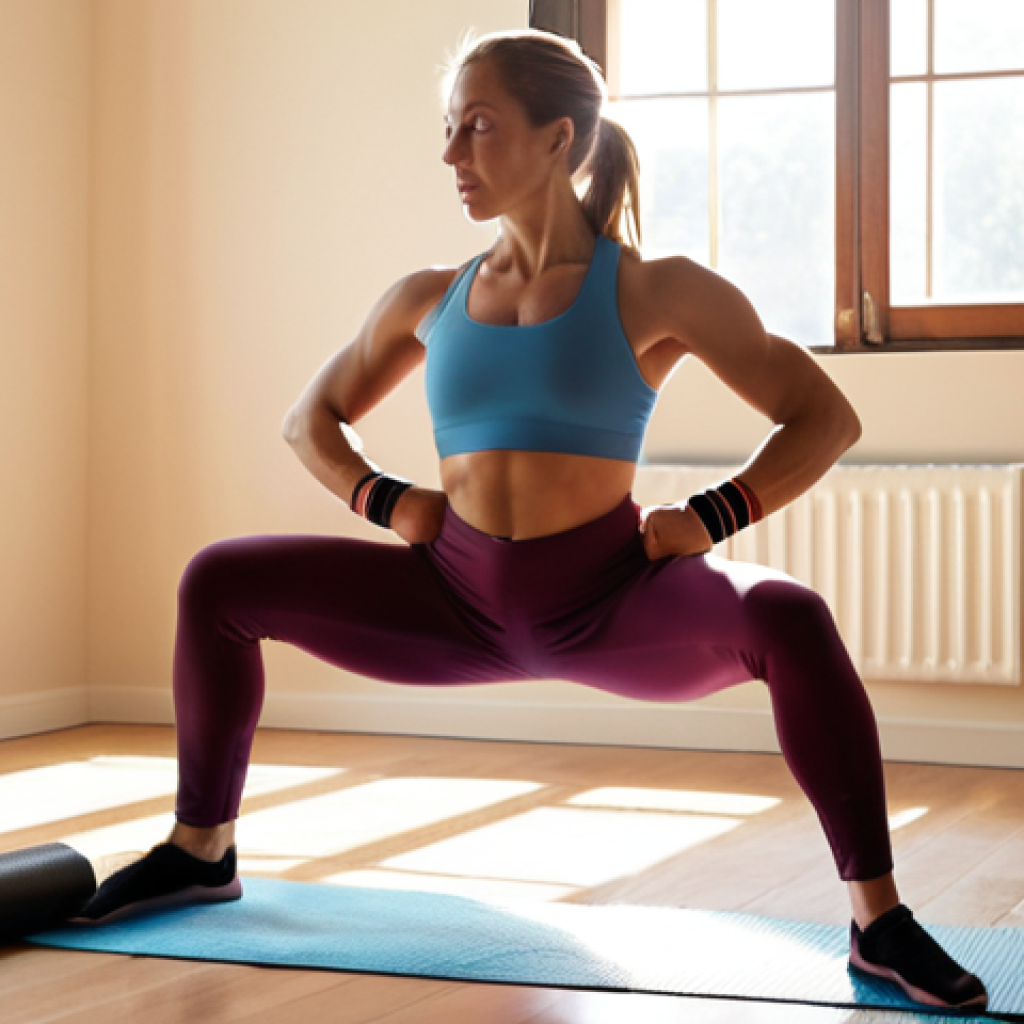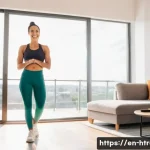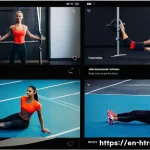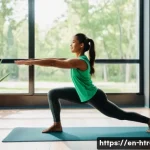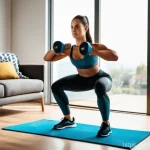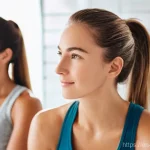Okay, here’s your blog intro:Feeling sluggish and ready to sculpt those legs without hitting the gym? Trust me, I’ve been there! I used to think effective leg workouts meant endless squats at some fancy fitness center, but guess what?
You can achieve incredible results right in your living room. From my own experience, a little dedication and the right moves can seriously transform your lower body.
Forget expensive equipment; bodyweight exercises and maybe some resistance bands are all you need to get started. It’s about consistency, not complexity.
Let’s dive in and get the lowdown on how to make those home leg workouts count.
Okay, here is the blog post body.
1. Mastering the Bodyweight Basics
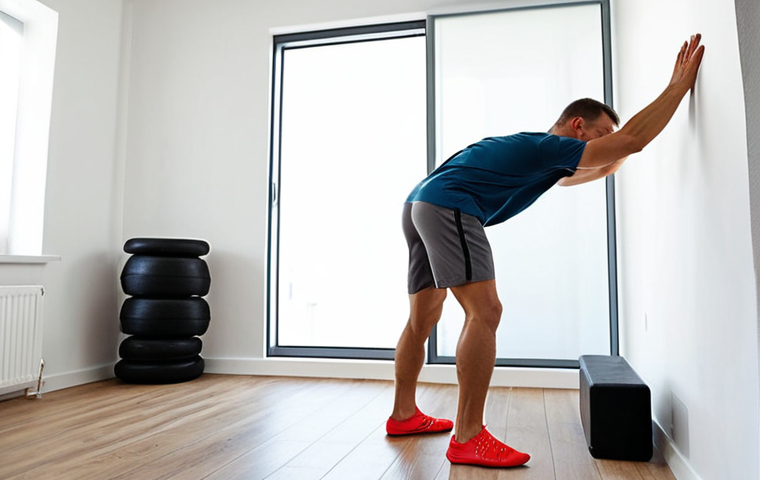
1.1. The Power of Squats
Squats, oh squats! They’re the cornerstone of any solid leg workout. I remember when I first started, I could barely do ten without feeling like my legs were going to give way. But trust me, the more you do them, the stronger you get. The key is to focus on form. Keep your back straight, chest up, and go as low as you comfortably can. Imagine you’re sitting back into a chair. Start with three sets of 15 reps, and gradually increase as you get stronger. I like to switch it up with variations like sumo squats (feet wider apart, toes pointed out) to target different muscles.
1.2. Lunges for Length and Strength
Lunges are another fantastic exercise. They target your quads, glutes, and hamstrings, plus they really work on your balance. There are so many variations too! Forward lunges, reverse lunges, lateral lunges… each hits your muscles in a slightly different way. I always found reverse lunges a bit easier on my knees, especially when I was starting out. Make sure your front knee doesn’t go past your toes and that you’re engaging your core throughout the movement. Aim for three sets of 12 reps per leg.
2. Level Up with Resistance Bands
2.1. Banded Squats: Amplifying the Burn
Once you’ve mastered the bodyweight squat, adding a resistance band can take things to a whole new level. Place the band around your thighs, just above your knees. This adds extra resistance, forcing your muscles to work harder. I’ve found this simple addition makes a world of difference. The extra tension really fires up your glutes and outer thighs. Remember to maintain proper form, and don’t let your knees cave in. Try doing three sets of 15-20 reps.
2.2. Banded Glute Bridges: Target Those Glutes
Glute bridges are great for targeting your glutes and hamstrings. Placing a resistance band around your thighs takes this exercise up a notch. Lie on your back with your knees bent and feet flat on the floor. Place the band around your thighs, just above your knees. Squeeze your glutes and lift your hips off the floor, keeping your core engaged. Hold for a second at the top, then slowly lower back down. The band adds extra resistance, forcing your glutes to work harder. I aim for three sets of 20 reps.
- Glute bridges are great for targeting your glutes
- Hamstrings and resistance bands take this exercise up a notch
3. Adding a Plyometric Punch
3.1. Jump Squats: Explosive Power
Ready to add some explosive power to your leg workout? Jump squats are the way to go. They’re basically squats with a jump at the top. I remember the first time I tried these; I was winded after just a few reps. But they’re so effective for building strength and power in your legs. Make sure to land softly to protect your knees. Start with three sets of 10 reps and gradually increase as you get stronger. These really get your heart rate up!
3.2. Lunge Jumps: Cardio and Strength Combined
Lunge jumps are another fantastic plyometric exercise. They combine the benefits of lunges with the added challenge of a jump. Start in a lunge position, then jump and switch your legs in the air, landing in a lunge position with the opposite leg forward. These are tough, but they’re incredibly effective for building strength, power, and cardiovascular fitness. Aim for three sets of 10 reps per leg. I always feel the burn with these!
- They combine the benefits of lunges with the added challenge of a jump.
- Lunge jumps are another fantastic plyometric exercise.
4. Focusing on Hamstrings
4.1. Nordic Hamstring Curls (Assisted)
Nordic hamstring curls are notoriously difficult, but incredibly effective for strengthening your hamstrings. Since you’re working out at home, you’ll need a little assistance for this one. You can either anchor your feet under a sturdy piece of furniture or have a partner hold your ankles. Kneel on the floor with your feet secured, and slowly lower your upper body towards the floor, controlling the movement with your hamstrings. Use your hands to catch yourself before you hit the ground, then push back up to the starting position. Start with three sets of as many reps as you can manage.
4.2. Single-Leg Deadlifts
Single-leg deadlifts are fantastic for improving balance, stability, and hamstring strength. Stand on one leg with a slight bend in your knee. Hinge at your hips, lowering your torso towards the floor while extending your other leg straight back behind you. Keep your back straight and your core engaged. Lower as far as you comfortably can, then return to the starting position. You might need to hold onto a wall for balance at first. Aim for three sets of 10-12 reps per leg.
5. Don’t Forget the Calves
5.1. Calf Raises: Simple but Effective
Calf raises are a super simple exercise, but they’re really effective for strengthening your calf muscles. You can do them anywhere, anytime. Stand on a flat surface, then rise up onto your toes, lifting your heels off the ground. Hold for a second at the top, then slowly lower back down. I like to do these while I’m waiting for the kettle to boil! Aim for three sets of 15-20 reps.
5.2. Single-Leg Calf Raises: Amplifying the Intensity
To make calf raises even more challenging, try doing them on one leg. This forces your calf muscles to work even harder. Stand on one leg, then rise up onto your toes, lifting your heel off the ground. Hold for a second at the top, then slowly lower back down. You can hold onto a wall for balance if needed. Aim for three sets of 12-15 reps per leg. You’ll really feel the burn with these!
6. Cool-Down and Stretching
6.1. Why Cool-Down Matters
Never skip the cool-down! It’s essential for preventing muscle soreness and improving flexibility. After your workout, spend a few minutes doing some light cardio, like walking or jogging in place. This helps to gradually lower your heart rate and prevent blood from pooling in your legs. I find it’s a great way to transition from workout mode back to everyday life.
- Never skip the cool-down! It’s essential for preventing muscle soreness and improving flexibility.
6.2. Essential Leg Stretches
Stretching is key for maintaining flexibility and preventing injuries. Focus on stretching your quads, hamstrings, glutes, and calves. Hold each stretch for 30 seconds and breathe deeply. Some of my favorite leg stretches include quad stretches (holding your foot behind you), hamstring stretches (touching your toes), and calf stretches (leaning against a wall with one leg extended back). I always feel so much better after a good stretching session.
7. Staying Consistent: The Key to Success
7.1. Set Realistic Goals
Consistency is key when it comes to any workout routine. Start by setting realistic goals. Don’t try to do too much too soon. Begin with three workouts per week and gradually increase the frequency and intensity as you get stronger. I always found it helpful to write down my goals and track my progress. Seeing how far you’ve come can be a great motivator.
- Consistency is key when it comes to any workout routine.
7.2. Make It a Habit
The best way to stay consistent is to make your workouts a habit. Schedule them into your day like any other important appointment. Find a time that works for you and stick to it. It might take a few weeks, but eventually, your workouts will become a regular part of your routine. I like to set a reminder on my phone so I don’t forget. And remember, even a short workout is better than no workout at all!
| Exercise | Sets | Reps | Tips |
|---|---|---|---|
| Squats | 3 | 15-20 | Keep back straight, chest up. |
| Lunges | 3 | 12 per leg | Ensure front knee doesn’t go past toes. |
| Banded Squats | 3 | 15-20 | Maintain proper form, knees out. |
| Glute Bridges | 3 | 20 | Squeeze glutes, engage core. |
| Jump Squats | 3 | 10 | Land softly. |
| Calf Raises | 3 | 15-20 | Full range of motion. |
In Closing
So, there you have it – a comprehensive guide to building leg strength at home using mostly just your body and a few affordable tools. Remember, consistency is paramount. Don’t get discouraged if you don’t see results overnight. Just keep showing up, pushing yourself, and listening to your body. I’ve personally found that incorporating these exercises regularly has not only boosted my physical strength but also my overall energy levels and confidence. Here’s to stronger, healthier legs!
Handy Tips to Know
1. Warm-Up is Key: Always start with 5-10 minutes of light cardio and dynamic stretching before jumping into your workout. Think leg swings, arm circles, and torso twists to get your muscles ready.
2. Listen to Your Body: Don’t push through pain. It’s better to modify an exercise or take a rest day than to risk injury. I learned this the hard way after pushing too hard during jump squats and tweaking my knee!
3. Stay Hydrated: Drink plenty of water before, during, and after your workout. Dehydration can lead to muscle cramps and fatigue.
4. Progressive Overload: Gradually increase the intensity of your workouts over time. This could mean adding more reps, sets, or resistance. It’s all about challenging yourself to keep growing.
5. Fuel Your Body Right: A balanced diet with plenty of protein, carbs, and healthy fats is essential for muscle recovery and growth. I always make sure to have a protein-rich snack after my leg workouts.
Key Takeaways
Focus on proper form to prevent injuries and maximize results.
Consistency trumps intensity; regular, shorter workouts are better than infrequent, grueling ones.
Incorporate variations of each exercise to target different muscle groups and prevent boredom.
Don’t neglect the cool-down and stretching – it’s crucial for recovery and flexibility.
Set realistic goals and track your progress to stay motivated and see how far you’ve come.
Frequently Asked Questions (FAQ) 📖
Q: I’m super busy! How many times a week should I realistically aim to work out my legs at home to see results?
A: Okay, so you’re juggling a million things – I get it! Honestly, even 2-3 focused sessions per week can make a noticeable difference. From my own experience, it’s better to do a shorter, intense workout that you can actually commit to consistently than trying to squeeze in a marathon session once in a blue moon.
Listen to your body, and don’t push yourself too hard at first! Trust me, sticking to a manageable routine is key.
Q: I don’t have any fancy workout equipment.
A: re bodyweight exercises really enough to build muscle in my legs? A2: Absolutely! Don’t underestimate the power of bodyweight exercises.
I was skeptical at first too, but exercises like squats, lunges, calf raises, and glute bridges, done with proper form, can seriously challenge your muscles.
I even started incorporating variations like pistol squats (though those are tough!), jump squats, and Bulgarian split squats to make things more challenging as I got stronger.
You can always add resistance bands later if you feel you need an extra push, but honestly, bodyweight is a fantastic place to start.
Q: I often experience knee pain.
A: re there any low-impact leg exercises I can do at home without aggravating my knees? A3: Knee pain is a real bummer, I know! The good news is there are definitely modifications you can make and low-impact exercises to try.
Wall sits (holding a seated position against a wall) are excellent for building strength with minimal stress on the knees. Glute bridges, hamstring curls using a towel on a smooth floor, and modified squats (only going down a quarter of the way) are also great options.
Always listen to your body, and stop if you feel any sharp pain. Consulting a physical therapist for personalized advice is always a smart move if you’re concerned.
📚 References
Wikipedia Encyclopedia
구글 검색 결과
구글 검색 결과
구글 검색 결과
구글 검색 결과
구글 검색 결과
